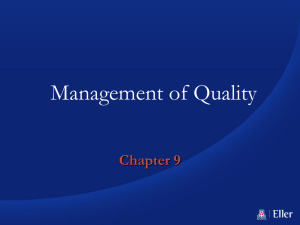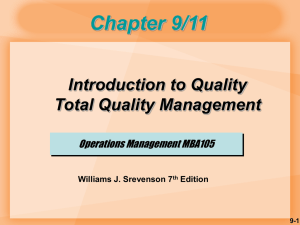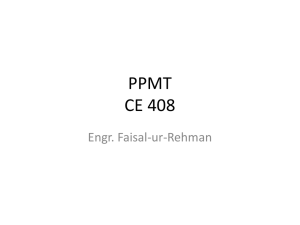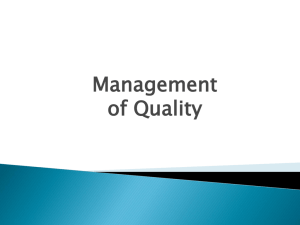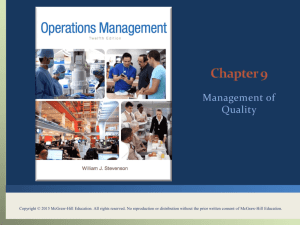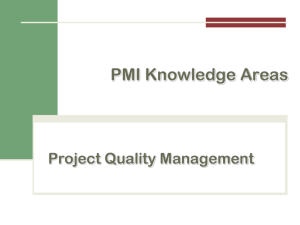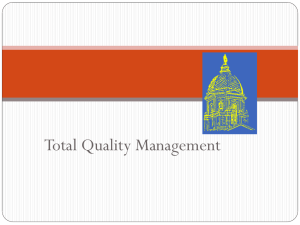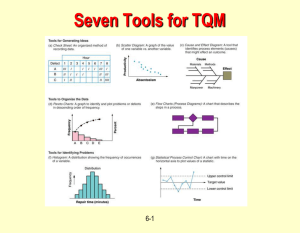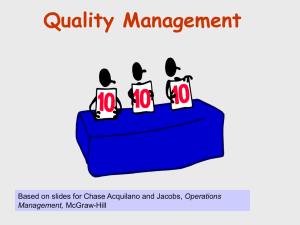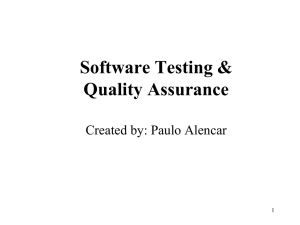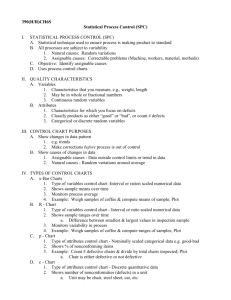quality assurance
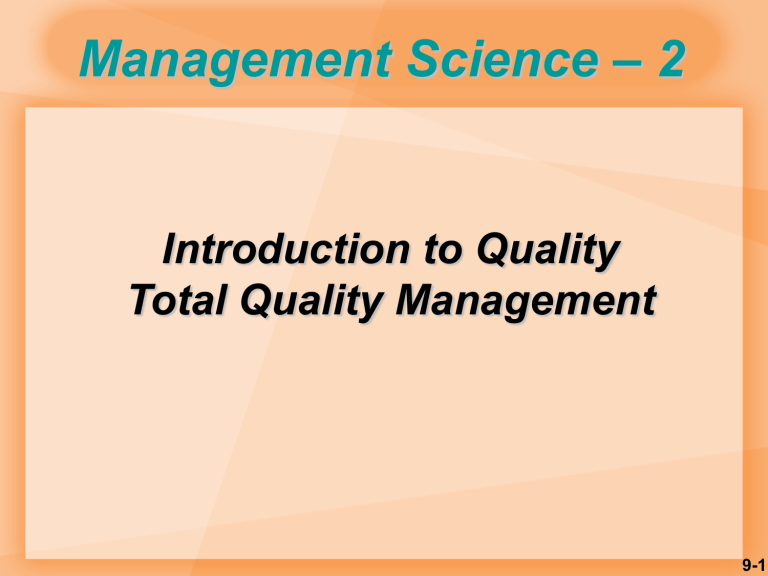
Management Science – 2
Introduction to Quality
Total Quality Management
9-1
Quality Management
What does the term quality mean?
Quality is the ability of a product or service to consistently meet or exceed customer expectations.
degree of excellence of a thing.
Totality of features and characteristics that satisfy needs
9-2
Evolution of Quality Management
Fredrick Taylor (Scientific Management)
1924 - Statistical process control charts
1930 - Tables for acceptance sampling
1940’s - Statistical sampling techniques
1950’s - Quality assurance/TQC (
DEMING)
1960’s - Zero defects
1970’s - Quality assurance in services
9-3
Quality Assurance vs. Strategic
Approach
Quality Assurance
Emphasis on finding and correcting defects before reaching market
Strategic Approach
Proactive, focusing on preventing mistakes from occurring
Greater emphasis on customer satisfaction
9-4
Dimensions of Quality
Performance
basic operating characteristics of a product; how well a car is handled.
Features
“extra” items added to basic features, such as a stereo CD or a leather interior in a car
Reliability
probability that a product will operate properly within an expected time frame; that is, a TV will work without repair for about seven years
9-5
Dimensions of Quality (Cont’d)
Conformance
degree to which a product meets pre – established standards
Durability
how long product lasts before replacement
Serviceability
ease of getting repairs, speed of repairs, courtesy and competence of repair person
9-6
Dimensions of Quality (Cont’d)
Aesthetics
how a product looks, feels, sounds, smells, or tastes
Safety
assurance that customer will not suffer injury or harm from a product; an especially important consideration for automobiles
Perceptions
subjective perceptions based on brand name, advertising, and the like
9-7
Examples of Quality Dimensions
Dimension
1. Performance
2. Aesthetics
3. Special features
(Product)
Automobile
Everything works, fit & finish Ride, handling, grade of materials used
Interior design, soft touch
Gauge/control placement
Cellular phone, CD player
(Service)
Auto Repair
All work done, at agreed priceFriendliness, courtesy, Competency, quickness
Clean work/waiting area
Location, call when ready
Computer diagnostics
9-8
Examples of Quality Dimensions
(Cont’d)
Dimension (Product) (Service)
Automobile Auto Repair
5. Reliability Infrequency of breakdowns Work done correctly, ready when promised
6. Durability Useful life in miles, resistance Work holds up over to rust & corrosion time
7. Perceived Top-rated car Award-winning service
quality department
8. Serviceability complaints and/or requests for information
Handling of complaints
9-9
Dimensions of Quality: Service
Time and Timeliness
How long must a customer wait for service, and is it completed on time?
Is an overnight package delivered overnight?
Completeness:
Is everything customer asked for provided?
Is a mail order from a catalogue company complete when delivered?
9-10
Dimensions of Quality: Service
Courtesy:
How are customers treated by employees?
Are catalogue phone operators nice and are their voices pleasant?
Consistency
Is the same level of service provided to each customer each time?
Is your newspaper delivered on time every morning?
9-11
Dimensions of Quality: Service
Accessibility and convenience
How easy is it to obtain service?
Does a service representative answer you calls quickly?
Accuracy
Is the service performed right every time?
Is your bank or credit card statement correct every month?
9-12
Dimensions of Quality: Service
Responsiveness
How well does the company react to unusual situations?
How well is a telephone operator able to respond to a customer’s questions?
9-13
Challenges with Service Quality
Customer expectations often change
Different customers have different expectations
Each customer contact is a “moment of truth”
Customer participation can affect perception of quality
Fail-staffing must be designed into the system
9-14
Quality Gurus
Walter Shewart
In 1920s, developed control charts
Introduced the term “ quality assurance”
W. Edwards Deming
Developed courses during World War II to teach statistical quality-control techniques to engineers and executives of companies that were military suppliers
After the war, began teaching statistical quality control to
Japanese companies
Joseph M. Juran
Followed Deming to Japan in 1954
Focused on strategic quality planning
9-15
Quality Gurus (cont.)
Armand V. Feigenbaum
In 1951, introduced concepts of total quality control and continuous quality improvement
Philip Crosby
In 1979, emphasized that costs of poor quality far outweigh the cost of preventing poor quality
In 1984, defined absolutes of quality management — conformance to requirements, prevention, and “zero defects”
Kaoru Ishikawa
Promoted use of quality circles
Developed “fishbone” diagram
Emphasized importance of internal customer
9-16
Determinants of Quality (cont’d)
Quality of design
Intension of designers to include or exclude features in a product or service:
Different car models with different features
size
Appearance
Roominess
Fuel economy
Comfort
Material used
9-17
Determinants of Quality (cont’d)
Quality of Conformance
Making sure a product or service is produced according to design:
if new tires do not conform to specifications, they wobble
if a hotel room is not clean when a guest checks in, the hotel is not functioning according to specifications of its design
9-18
The Consequences of Poor Quality
Loss of business
Liability
Productivity
Costs
9-19
Benefits of Good Quality
Organizations will benefit in different way:
Enhance reputation
Increase market share
Greater customer loyalty
Lower liability Cost
Fewer complains
Lower production cost
Higher profits
9-20
Responsibility for Quality
Top management
Design
Procurement
Production/operations
Quality assurance
Packaging and shipping
Marketing and sales
Customer service
9-21
Costs of Quality
Failure Costs - costs incurred by defective parts/products or faulty services.
Internal Failure Costs
Costs incurred to fix problems that are detected during the production.
Defective materials
Incorrect machine setting
Faulty equipment
Carelessness
Wrong procedure
9-22
Costs of Quality
External Failure Costs
All costs incurred to fix problems that are detected after the product/service is delivered to the customer.
Warranty work
Handling of complains
Replacement
Liability
9-23
Costs of Quality (continued)
Appraisal Costs
Costs of activities designed to ensure quality or uncover defects
Cost of inspector
Testing
Test equipment
Labs
Field testing
9-24
Costs of Quality (continued)
Prevention Costs
Cost of preventing defects form occurring
Planning and adminstration
Working with vendors
Training
Quality control procedures
9-25
Total Quality Management
A philosophy that involves everyone in an organization in a continual effort to improve quality and achieve customer satisfaction.
Continuous Improvement
Involvement of Everyone
Customer Satisfaction
9-26
Elements of TQM
1. Continual improvement ( never ending)
2. Competitive benchmarking
3. Employee empowerment
4. Team approach
5. Decisions based on facts
6. Knowledge of tools
7. Supplier quality
8. Champion
9. Quality at the source
10. Suppliers
9-27
Quality at the Source
The philosophy of making each worker responsible for the quality of his or her work.
9-28
Basic Quality Tools
Flowcharts
Check sheets
Histograms
Pareto Charts
Scatter diagrams
Control charts
Cause-and-effect diagrams
Run charts
9-29
Quality Tools
Flow Chart : displays the steps in a process showing order and relationships helps in understanding of that process and identifies potential weaknesses i.e.
poor performance
Cause and Effect
Also know as fishbone or Ishikawa
9-30
Quality Tools
Pareto Chart a form of bar-chart which displays the relative importance of problems or conditions by ordering frequency and showing the cumulative effect
Histogram displaying variation in a process trying to explain the cause of it
Note: Box Whisker Plots would be a useful addition to this
Scatter Graph looks for relationships between factors and displays their strength
9-31
Quality Tools
Clustering
Reduces complexity or size of data set by grouping ideas under headingsUseful for qualitative data from questionnaires
Filtering ideas
Reduces ideas by asking questions e.g. Is the idea feasible? Affordable? Is it within our control? Would it improve the situation?
9-32
Check Sheet
COMPONENTS REPLACED BY LAB
TIME PERIOD: 22 Feb to 27 Feb 2002
REPAIR TECHNICIAN: Bob
TV SET MODEL 1013
Integrated Circuits
Capacitors
Resistors
Transformers
Commands
CRT |
||||
|||| |||| |||| |||| |||| ||
||
||||
9-33
Cause-and-Effect Diagram
Figure 9.12
Human Machines Measurement
Faulty testing equipment
Poor supervision Out of adjustment
Tooling problems Incorrect specifications
Improper methods
Lack of concentration
Inadequate training
Old / worn
Quality
Problem Inaccurate temperature control
Dust and Dirt
Defective from vendor
Not to specifications
Materialhandling problems
Poor process design
Ineffective quality management
Deficiencies in product design
Process Environment Materials
9-34
Methods for Generating Ideas
Brainstorming
Quality circles
Interviewing
Benchmarking
9-35
